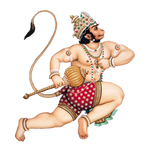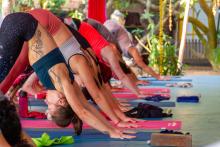You are here
Kranti Yoga Tradition
yoga teacher training in goa
With over 12 years of Yoga Teacher Training in Goa, India. Kranti Yoga Tradition is a Yoga Teacher Training School, directly on Patnem Beach, South Goa. We offer 200 Hour Yoga TTC, 300 Hour Yoga TTC, 500 Hour Yoga TTC in Ashtanga Yoga, Yin Yoga and Vinyasa Flow alongside Yoga Intensives, Yoga Immersions and Yoga Holidays right on the beach in beautiful Goa.
Favorite Poses:
Blog Posts
Posted: Mar 19
Yoga mudras: what are the types of yoga mudra, how do we practice yoga mudras, and what are the beneficial effects of mudras? Mudra means "seal", "gesture" or "mark". And simply put, yoga mudras are gestures or shapes we make with our hands.
Asana Sequences
Tree posture, known as Vrikshasana in Sanskrit, is an excellent posture for everyone practicing yoga – from beginners to advanced practitioners. Regular practice of vrikshasana will help to build strength and stabilise the ankle joint, help strengthen and charge the core, and improve the practitioners balance. First, we'll instruct the basic alignment and cues to get you into your vrikshasana, take a more in depth look at some of the tree yoga benefits, and then finish with some modifications or versions of a tree yoga asana that can diversify the posture, it’s benefits, and your practice.
So, how to do Vrikshasana? From equal standing, engage to inhale the right leg and position it on the inside of the left thigh, calf, or your toes can rest gently on the ground as you lean the foot inside the standing leg. Press weight into all four corners of the standing foot, and simultaneously draw energy up from the ground as you root yourself into the floor. Focus on externally rotating the right hip and pressing your foot into your leg, and your leg into your foot.
Find length in the spine and grow the crown of the head to the sky. Try to focus on an upwards current of energy. You do not want to press the foot into the supporting knee, as this will put unnecessary pressure on this joint, inside the thigh or the calf is ideal. There are many options for our hand placement, which we will explore in a moment, but typically our hands come into heart centre to our Namaskar mudra. If you follow these easy steps, you will benefit from this posture.
You can hold here for a few breaths, or even a few minutes, depending on your practice.Tree yoga benefits mainly include our ankle stabilisation, core and leg strengthening, as well as working on our balance. But there are also subtle benefits we can focus on in this posture, and ways we can adapt vrikshasana to make it more challenging. Energetically, we can benefit from practicing tree to experience a simultaneous expansion of energy – rooting down and lifting up – becoming more aware of how we control and direct our energy. And consequently, cultivating balance and rooting yourself by practicing tree can help you feel more balanced and centred within yourself and your life off the mat.
For a challenge in this posture, try closing your eyes. It will make balancing all the more difficult and really test your skills. You can also experiment with the arm placement, on the hips, or over the head for some shoulder work. Perhaps even adding some dynamic movements sweeping the arms up and down or left and right to mimic the branches of a tree flowing. This too will challenge your balance skills.
For more details: https://www.krantiyoga.com/most-common-types-of-yoga.html
A List of Asana in this Sequence:
Are you a Yoga Teacher?
Are you a Yoga Student?
Do you Own a Yoga Studio?

